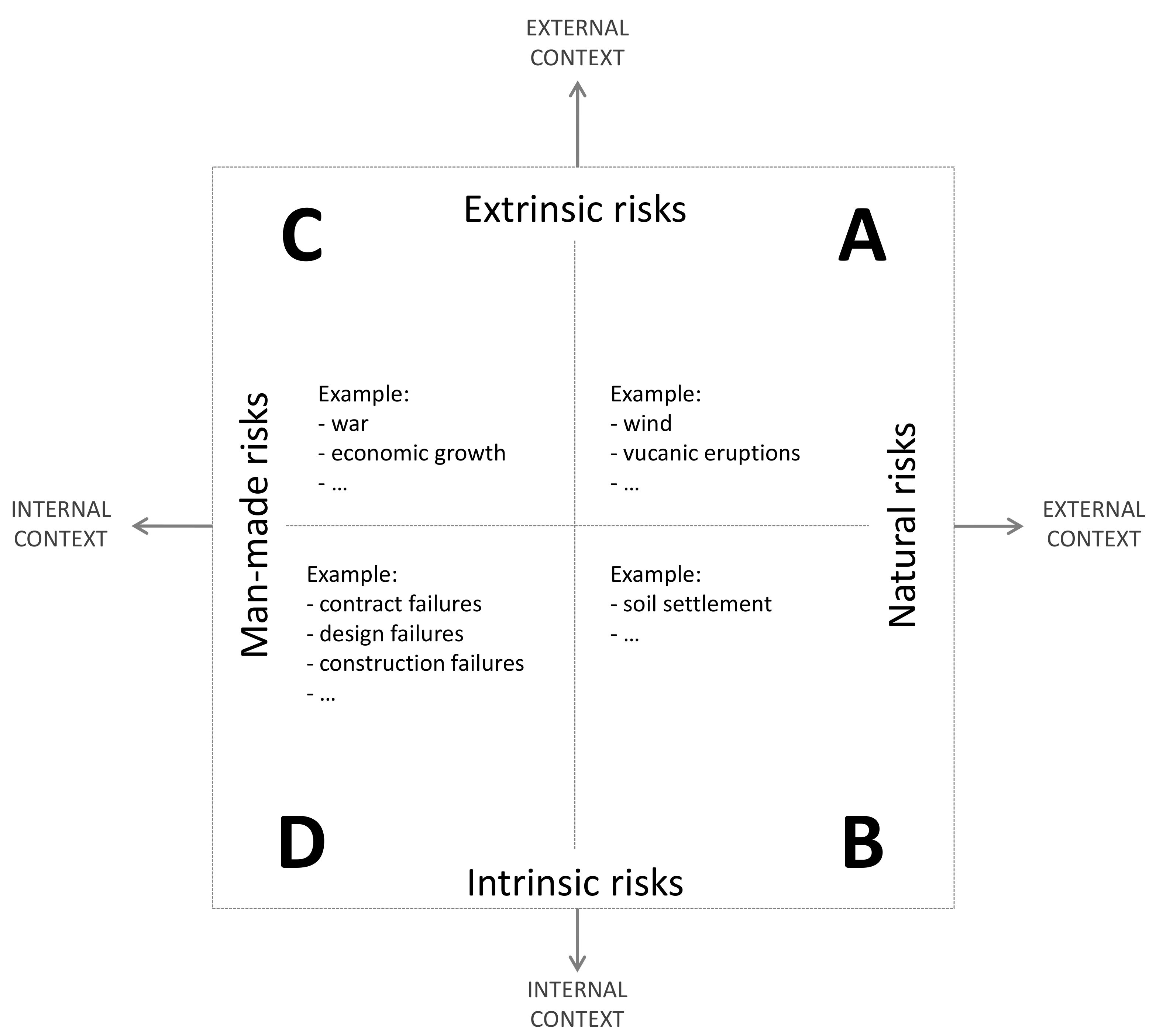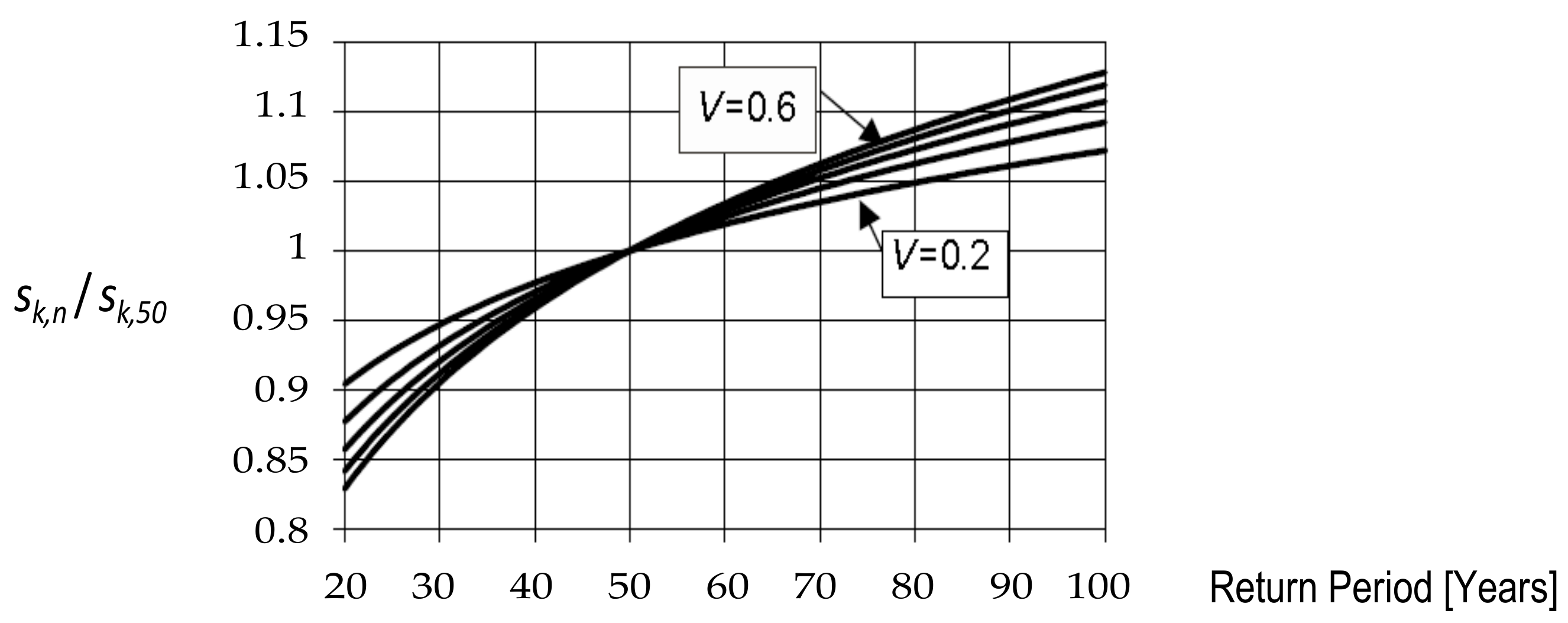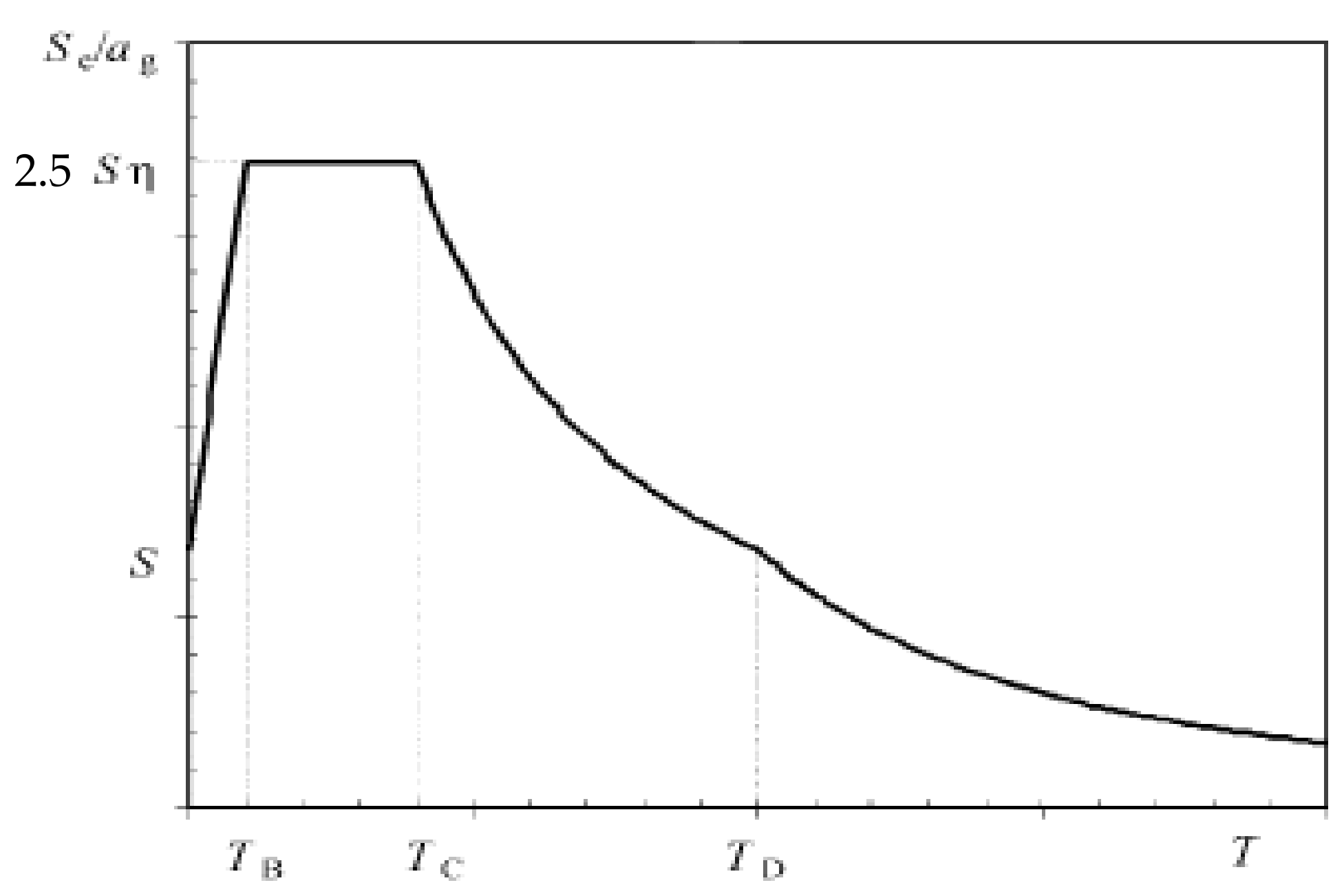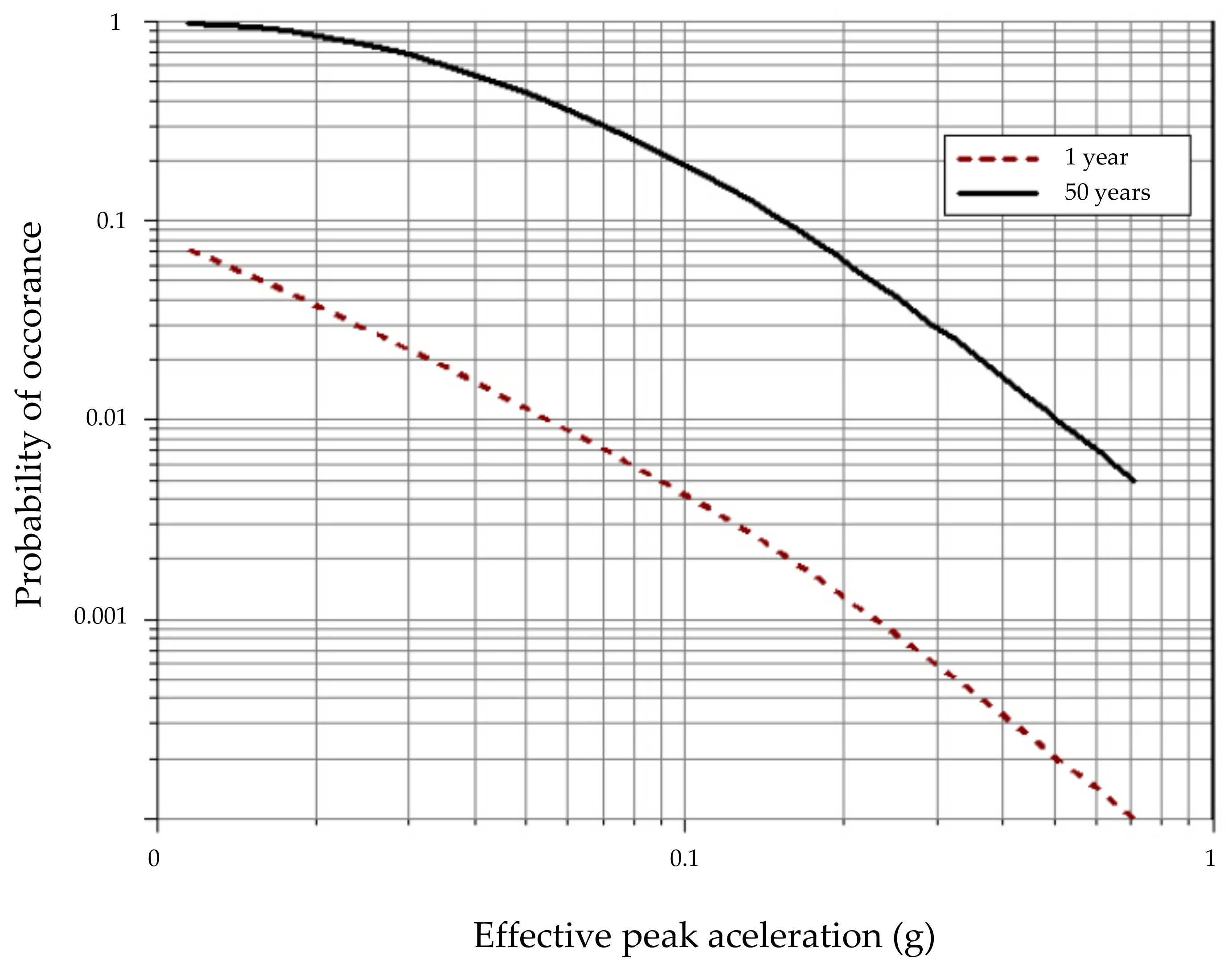Risk-Informed Performance-Based Metrics for Evaluating the Structural Safety and Serviceability of Constructed Assets against Natural Disasters
Abstract
1. Introduction
2. Natural Disasters and Resilience of the Built Environment
3. Rating System for Building Structural Safety and Serviceability
3.1. Risk-Informed Performance-Based Building Structures
3.2. Evaluating Building Structural Safety and Serviceability against Natural Disasters
3.3. Wind
3.4. Snow Action
3.5. Seismic Action
3.6. Other Actions
3.6.1. Flooding
3.6.2. Temperature Variations
4. Discussion
5. Conclusions
Author Contributions
Funding
Institutional Review Board Statement
Informed Consent Statement
Data Availability Statement
Acknowledgments
Conflicts of Interest
References
- Falcão Silva, M.J.; de Almeida, N.M.; Salvado, F.; Rodrigues, H. Modelling Structural Performance and Risk for Enhanced Building Resilience and Reliability. Innov. Infrastruct. Solut. 2020, 5, 26. [Google Scholar] [CrossRef]
- Cerѐ, G.; Rezgui, Y.; Zhao, W. Critical Review of Existing Built Environment Resilience Frameworks: Directions for Future Research. Int. J. Disaster Risk Reduct. 2017, 25, 173–189. [Google Scholar] [CrossRef]
- Almeida, N.M.D.; Sousa, V.; Dias, L.A.; Branco, F.A. Managing the Technical Risk of Performance-Based Building Structures. J. Civ. Eng. Manag. 2015, 21, 384–394. [Google Scholar] [CrossRef]
- Salvado, F.; de Almeida, N.M.; Vale e Azevedo, A. Toward Improved LCC-Informed Decisions in Building Management. Built Environ. Proj. Asset Manag. 2018, 8, 114–133. [Google Scholar] [CrossRef]
- Almeida, N.; Sousa, V.; Dias, L.A.; Branco, F. A Framework for Combining Risk-Management and Performance-Based Building Approaches. Build. Res. Inf. 2010, 38, 157–174. [Google Scholar] [CrossRef]
- Adedeji, T.J.; Proverbs, D.G.; Xiao, H.; Oladokun, V.O. Towards a Conceptual Framework for Property Level Flood Resilience. Int. J. SAFE 2018, 8, 493–504. [Google Scholar] [CrossRef]
- Cecconi, F.R.; Moretti, N.; Maltese, S.; Dejaco, M.; Kamara, J.; Heidrich, O. Un Rating System per La Resilienza Degli Edifici. TECHNE J. Technol. Archit. Environ. 2018, 358–365. [Google Scholar] [CrossRef]
- Burroughs, S. Development of a Tool for Assessing Commercial Building Resilience. Procedia Eng. 2017, 180, 1034–1043. [Google Scholar] [CrossRef]
- Proverbs, D.; Lamond, J. Flood Resilient Construction and Adaptation of Buildings. Available online: https://oxfordre.com/naturalhazardscience/view/10.1093/acrefore/9780199389407.001.0001/acrefore-9780199389407-e-111 (accessed on 19 May 2021).
- Reckien, D.; Creutzig, F.; Fernandez, B.; Lwasa, S.; Tovar-Restrepo, M.; Mcevoy, D.; Satterthwaite, D. Climate Change, Equity and the Sustainable Development Goals: An Urban Perspective. Environ. Urban. 2017, 29, 159–182. [Google Scholar] [CrossRef]
- Masood, T.; McFarlane, D.; Parlikad, A.K.; Dora, J.; Ellis, A.; Schooling, J. Towards the Future-Proofing of UK Infrastructure. Infrastruct. Asset Manag. 2016, 3, 28–41. [Google Scholar] [CrossRef]
- Almeida, N.; Sousa, V.; Alves Dias, L.M.; Branco, F. General framework for Risk-Managed Performance-Based Building (RM-PBB). In Proceedings W113 Special Track, 18th CIB World Building Congress; CIB Publication: Salford, UK, 2010. [Google Scholar]
- Hollnagel, E. Resilience Engineering and the Built Environment. Build. Res. Inf. 2014, 42, 221–228. [Google Scholar] [CrossRef]
- Almeida, N. Technical Model of Building Management Performance and Risk Based: Design, Development, and Example of Application to Structures. Ph.D Thesis, IST-ULisboa, Lisbon, Portugal, 2011. [Google Scholar]
- Klinke, A.; Renn, O. Precautionary Principle and Discursive Strategies: Classifying and Managing Risks. J. Risk Res. 2001, 4, 159–173. [Google Scholar] [CrossRef]
- Edwards, P.J.; Bowen, P.A. Risk and Risk Management in Construction: A Review and Future Directions for Research. Eng. Constr. Archit. Manag. 1998, 5, 339–349. [Google Scholar] [CrossRef]
- ISO 6241:1984, Performance Standards in Building—Principles for Their Preparation and Factors to Be Considered; ISO: Geneva, Switzerland, 2007.
- El-Sayegh, S.M. Risk Assessment and Allocation in the UAE Construction Industry. Int. J. Proj. Manag. 2008, 26, 431–438. [Google Scholar] [CrossRef]
- Palomo, J.; Insua, D.R.; Ruggeri, F. Modeling External Risks in Project Management. Risk Anal. 2007, 27, 961–978. [Google Scholar] [CrossRef]
- Barber, R.B. Understanding Internally Generated Risks in Projects. Int. J. Proj. Manag. 2005, 23, 584–590. [Google Scholar] [CrossRef]
- Tah, J.H.M.; Carr, V. Information Modelling for a Construction Project Risk Management System. Eng. Constr. Archit. Manag. 2000, 7, 107–119. [Google Scholar] [CrossRef]
- Vanier, D.; Lacasse, M.; Parsons, A. Using Product Models to Represent User Requirements. Construction on the Information Highway. In Proceedings of the CIB Workshop W78, Bled, Slovenia, 10–12 June 1996; pp. 511–524. [Google Scholar]
- Kohler, N. From the Design of Green Buildings to Resilience Management of Building Stocks. Build. Res. Inf. 2018, 46, 578–593. [Google Scholar] [CrossRef]
- Wilkinson, S.; Osmond, P. Building Resilience in Urban Settlements. Int. J. Build. Pathol. Adapt. 2018, 36, 334–336. [Google Scholar] [CrossRef]
- Ismail, F.Z.; Halog, A.; Smith, C. How Sustainable Is Disaster Resilience? An Overview of Sustainable Construction Approach in Post-Disaster Housing Reconstruction. Int. J. Disaster Resil. Built Environ. 2017, 8, 555–572. [Google Scholar] [CrossRef]
- Mehmood, A. Of Resilient Places: Planning for Urban Resilience. Eur. Plan. Stud. 2016, 24, 407–419. [Google Scholar] [CrossRef]
- Meacham, B.J. Sustainability and Resiliency Objectives in Performance Building Regulations. Build. Res. Inf. 2016, 44, 474–489. [Google Scholar] [CrossRef]
- Vale, L.J. The Politics of Resilient Cities: Whose Resilience and Whose City? Build. Res. Inf. 2014, 42, 191–201. [Google Scholar] [CrossRef]
- Hassler, U.; Kohler, N. Resilience in the Built Environment. Build. Res. Inf. 2014, 42, 119–129. [Google Scholar] [CrossRef]
- Wholey, F. Building Resilience: A Framework for Assessing and Communicating the Costs and Benefits of Resilient Design Strategies. Perkins Will Res. J. 2015, 7, 7–18. [Google Scholar]
- Francis, R.; Bekera, B. A Metric and Frameworks for Resilience Analysis of Engineered and Infrastructure Systems. Reliab. Eng. Syst. Saf. 2014, 121, 90–103. [Google Scholar] [CrossRef]
- Falcão Silva, M.J.; Almeida, N.; Salvado, F.; Rodrigues, H. Structural Performance Evaluation System for Improved Building Resilience and Reliability; CRC/Taylor and Francis Book on Reliability: Abingdon-on-Thames, UK, 2021. [Google Scholar]
- Achour, N.; Pantzartzis, E.; Pascale, F.; Price, A.D.F. Integration of Resilience and Sustainability: From Theory to Application. Int. J. Disaster Resil. Built Environ. 2015, 6, 347–362. [Google Scholar] [CrossRef]
- Meacham, B.J.; van Straalen, I.J.J. A Socio-Technical System Framework for Risk-Informed Performance-Based Building Regulation. Build. Res. Inf. 2018, 46, 444–462. [Google Scholar] [CrossRef]
- Roostaie, S.; Nawari, N.; Kibert, C.J. Sustainability and Resilience: A Review of Definitions, Relationships, and Their Integration into a Combined Building Assessment Framework. Build. Environ. 2019, 154, 132–144. [Google Scholar] [CrossRef]
- Saunders, W.S.A.; Becker, J.S. A Discussion of Resilience and Sustainability: Land Use Planning Recovery from the Canterbury Earthquake Sequence, New Zealand. Int. J. Disaster Risk Reduct. 2015, 14, 73–81. [Google Scholar] [CrossRef]
- Almeida, N.M.; Sousa, V.; Dias, L.A.; Branco, F. Engineering Risk Management in Performance-Based Building Environments. J. Civ. Eng. Manag. 2015, 21, 218–230. [Google Scholar] [CrossRef]
- Meacham, B. Performance-Based Building Regulatory Systems—Principles and Experiences; A Report of the Inter-Jurisdictional Regulatory Collaboration Committee s.l.; IRCC: Hamilton, ON, Canada, 2010. [Google Scholar]
- Spekkink, D. Performance Based Design of Buildings; PeBBu Domain 3 Final Report s.l.; CIB: Rotterdam, The Netherlands, 2005. [Google Scholar]
- Meacham, B. Performance Based-Building Regulatory System: Structure, Hierarchy and Linkages. J. Struct. Eng. Soc. N. Z. 2004, 17, 37–51. [Google Scholar]
- Lützkendorf, T.; Speer, T. Building Performance or Product Quality: What Information Should Be Signalled in Consumer Markets? In Proceedings of the Toronto: CIB World Building Congress, Toronto, ON, Canada, 2–7 May 2004. [Google Scholar]
- ISO/IEC Guide 67:2004. Conformity Assessment—Fundamentals of Product Certification, ISO Central Secretariat; ISO: Geneva, Switzerland, 2004.
- Duncan, J. Performance-Based Building: Lessons from Implementation in New Zealand. Build. Res. Inf. 2005, 33, 120–127. [Google Scholar] [CrossRef]
- ISO Guide 31:2015. Reference Materials—Contents of Certificates, Labels and Accompanying Documentation, ISO Central Secretariat; ISO: Geneva, Switzerland, 2015.
- Olawumi, T.O.; Chan, D.W.M. A Scientometric Review of Global Research on Sustainability and Sustainable Development. J. Clean. Prod. 2018, 183, 231–250. [Google Scholar] [CrossRef]
- Reed, R.; Bilos, A.; Wilkinson, S.; Schulte, K.-W. International Comparison of Sustainable Rating Tools. J. Sustain. Real Estate 2009, 1, 1–22. [Google Scholar] [CrossRef]
- Ling, F.Y.Y.; Hoi, L. Risks Faced by Singapore Firms When Undertaking Construction Projects in India. Int. J. Proj. Manag. 2006, 24, 261–270. [Google Scholar] [CrossRef]
- ISO/DIS 21929-1:2011. Sustainability in Building Construction—Sustainability Indicators—Part 1: Framework for the Development of Indicators and a Core Set of Indicators for Buildings; ISO: Geneva, Switzerland, 2011.
- Decreto-Lei 301/2007, 2007-08-23. Available online: https://dre.pt/pesquisa/-/search/640896/details/maximized (accessed on 18 May 2021).
- ISO 15928-1:2015. Houses—Description of Performance—Part 1: Structural Safety; ISO: Geneva, Switzerland, 2015.
- ISO 15928-2:2005. Houses—Description of Performance—Part 2: Structural Serviceability; ISO: Geneva, Switzerland, 2005.
- ISO 15928-3:2015. Houses—Description of Performance—Part 3: Structural Durability; ISO: Geneva, Switzerland, 2015.
- Fujitani, H.; Teshigawara, M.; Gojo, W.; Hirano, Y.; Saito, T. Framework for Performance-Based Design of Building Structures. Comput. Aided Civ. Infrastruct. Eng. 2005, 20, 62–77. [Google Scholar] [CrossRef]
- ISO 11863:2011. Buildings and Building-Related Assets—Functional and User Requirements and Performance in Building—Tools for Assessing and Comparing Functional Performance; ISO: Geneva, Switzerland, 2011.
- EN 1991-1-4:2010. Actions on Structures—Part 1–4: General Actions—Wind Actions; European Committee for Standardization: Brussels, Belgium, 2010.
- EN 1990:2002. Eurocode—Basis of Structural Design; European Committee for Standardization: Brussels, Belgium, 2002.
- ISO 4354:2009. Wind Actions on Structures; ISO: Geneva, Switzerland, 2009.
- ISO 22111:2019. Bases for Design of Structures—General Requirements; ISO: Geneva, Switzerland, 2019.
- ISO 2394:2015. General Principles on Reliability for Structures; ISO: Geneva, Switzerland, 2015.
- Holický, M.; Vrouwenvelder, T. Basic Concepts of Structural Reliability. In Handbook 2—Reliability Backgrounds: Guide to the Basis of Structural Reliability and Risk Engineering Related to Eurocodes, Supplemented by Practical Examples s.l.; Leonardo Da Vinco Pilot Project CZ/02/B/f/PP-134007; Chapter I. Joint Research Centre Eurocodes; 2005; Available online: https://eurocodes.jrc.ec.europa.eu/showpublication.php?id=63 (accessed on 24 May 2021).
- The Housing Quality Assurance Act and Japan Housing Performance Indication Standards; The Building Center of Japan: Tokyo, Japan, 2005.
- EN 1991-1-3:2009. Actions on Structures—Part 1–3: General Actions—Snow Loads; European Committee for Standardization: Brussels, Belgium, 2009.
- Formichi, P. EN 1991—Eurocode 1: Actions on Structures—Part 1–3 General Actions—Snow Loads. Eurocodes—Background and Applications. In Proceedings of the Dissemination of Information Workshop, Brussels, Belgium, 18–20 February 2008. [Google Scholar]
- ISO 4355:2013. Bases for Design of Structures—Determination of Snow Loads on Roofs; ISO: Geneva, Switzerland, 2013.
- Holický, M.; Marková, J. Reliability Diferentiation. In Handbook 2—Reliability Backgrounds: Guide to the Basis of Structural Reliability and Risk Engineering Related to Eurocodes, Supplemented by Practical Examples s.l.; Leonardo Da Vinco Pilot Project CZ/02/B/f/PP-134007; Chapter III. Joint Research Centre Eurocodes; 2005; Available online: https://eurocodes.jrc.ec.europa.eu/showpublication.php?id=63 (accessed on 24 May 2021).
- ISO 3010:2017. Basis for Design of Structures—Seismic Actions on Structures; ISO: Geneva, Switzerland, 2017.
- EN 1998-1:2004. Design of Structures for Earthquake Resistance—Part 1: General Rules, Seismic Actions and Rules for Buildings; European Committee for Standardization: Brussels, Belgium, 2004.
- Solomos, G.; Pinto, A.; Dimova, S. A Review of the Seismic Hazard Zonation in National Building Codes in the Context of Eurocode 8—Support to the Implementation, Harmonization, and Further Development of the Eurocodes; JRC Scientific and Technical Reports; European Commission Joint Research Centre: Ispra, Italy, 2008. [Google Scholar]
- Fardis, M. Earthquake-Resistant Design of Concrete Buildings According to EN1998-1 (Eurocode 8); European Commission: Brussels, Belgium, 2008. [Google Scholar]
- EN 1991-1-5:2003. Actions on Structures—Part 1–5: General Actions—Thermal Actions; European Committee for Standardization: Brussels, Belgium, 2003.
- Holický, M.; Marková, J. Thermal Actions; Technical Report; Technical University in Prague: Prague, Czech Republic, 2008. [Google Scholar]




| Agent | Parametrization |
|---|---|
| Wind actions | Representative value of wind speed (or dynamic wind pressure) Annual probability of occurrence (or average return period) Parameters for differentiating reliability (partial safety factor γQ, multiplication factor K) |
| Snow actions | Representative values of snow accumulation (meteorological data or characteristic snow load at ground level) Annual probability of occurrence (or average return period) Parameters for differentiating reliability (partial safety factor γQ, multiplication factor K) |
| Seismic actions | Representative value of seismic activity (effective peak ground acceleration, ground acceleration response spectrum or others) Probabilities of occurrence (or average return periods) Parameters for differentiating reliability (importance coefficient γI, multiplication factor K) |
| Other actions | Representative parameters of other actions |
| Agent | Parametrization |
|---|---|
| Wind actions | Same as Table 1 |
| Snow actions | Same as Table 1 |
| Seismic actions | Same as Table 1 Floor acceleration response (for equipment and non-structural components) |
| Other actions | Same as Table 1 |
| New Buildings | Existing Buildings | ||
|---|---|---|---|
| Class | General Calibration Rule | Rating | General Calibration Rule |
| A+ | Exceptionally demanding | 9 | Exceptionally demanding or non-applicable |
| A | Clearly above average, but not the exceptionally demanding | [7,9] | Clearly above average, but not the exceptionally demanding |
| B | Typical mid-range or normal | [5,7] | Typical mid-range or normal |
| C | Unacceptable in any circumstance | [3,5] | Clearly below average, but acceptable under justified circumstances |
| D | Unacceptable in any circumstance | [1,3] | Exceptionally below average, but acceptable under exceptional and justified circumstances |
| N/A | Non-applicable | 0 | Unacceptable, not required or non-applicable |
| Medium Return Period (n Years) | 2 | 5 | 10 | 50 | 100 | 200 | 500 | 1000 | 2500 |
|---|---|---|---|---|---|---|---|---|---|
| Annual probability of occurrence p | 0.5 | 0.2 | 0.1 | 0.02 | 0.01 | 0.005 | 0.002 | 0.001 | 0.0004 |
| Modification coefficient cprob | 0.77 | 0.85 | 0.90 | 1 | 1.04 | 1.08 | 1.12 | 1.16 | 1.20 |
| Importance Group | Reliability Index (Probability of Failure) | Annual Probability of Occurrence of the Design Value of the Wind Action |
|---|---|---|
| I | 2.3 (10−2) | 1:200 to 1:500 |
| II (current situation) | 3.1 (10−3) | 1:500 to 1:1000 |
| III | 3.7 (10−4) | 1:1000 to 1:2500 |
| IV | 4.2 (10−5) | Determined case by case |
| Mean Return Period (n Years) | 2 | 5 | 10 | 50 | 100 | 250 | 500 | 750 | 1000 |
|---|---|---|---|---|---|---|---|---|---|
| Annual probability of occurrence p | 0.5 | 0.2 | 0.1 | 0.02 | 0.01 | 0.004 | 0.002 | 0.0013 | 0.001 |
| Modification coefficient cprob | 0.64 | 0.75 | 0.83 | 1 | 1.07 | 1.17 | 1.24 | 1.28 | 1.31 |
| Importance Group | Annual Probability of Occurrence of the Calculation Value of the Snow Action |
|---|---|
| I | 1:250 |
| II (normal situation) | 1:500 |
| III | 1:750 |
| IV | Determined case by case |
| Importance Class | γI |
|---|---|
| I | 0.8 |
| II | 1.0 |
| III | 1.2 |
| IV | 1.4 |
| Performance Class | TR | PR | Estimation of Modified Values for γI | ||||||
|---|---|---|---|---|---|---|---|---|---|
| k = 2 | k = 2.5 | k = 3 | k = 3.5 | k = 4 | k = 4.5 | k = 5 | |||
| B (ref.) | 475 | 10% | 1 | 1 | 1 | 1 | 1 | 1 | 1 |
| A | 1000 | 4.9% | 1.43 | 1.33 | 1.27 | 1.23 | 1.20 | 1.17 | 1.15 |
| A+ | 1500 | 3.3% | 1.75 | 1.56 | 1.45 | 1.38 | 1.32 | 1.28 | 1.25 |
| Probability of Occurrence PR | Period TL | Mean Return Period TR |
|---|---|---|
| 10% | 50 years | 475 years |
| 5% | 50 years | 975 years |
| 10% | 100 years | 949 years |
| 5% | 1000 years | 1950 years |
| Agent | Class | Evaluation Criteria |
|---|---|---|
| Wind action | A+ | Use of the representative value of the wind speed (w) corresponding to a very rare event (for example, equivalent to an average return period between 1000 and 2500 years) and a design value Qd,w obtained by increasing the legal partial safety coefficient γQ compounded with a multiplicative factor KA+ = 1.1 |
| A | Use of the representative value of the wind speed (w) corresponding to the very rare event (for example, equivalent to an average return period between 1000 and 2500 years) and a design value Qd,w obtained by using the legal partial safety factor γQ (KA = 1.0) | |
| B | Use of the representative value of the legal wind speed (w) (for example, equivalent to an average return period between 500 and 1000 years) and a design value Qd,w obtained by using the legal partial safety factor γQ (KB = 1.0) | |
| Snow action | A+ | Use of the characteristic value of the snow load at ground level (sk) corresponding to a very rare event (for example, equivalent to an average return period of 750 years) and a design value Qd,s obtained by increasing the legal partial safety factor γQ compounded with a multiplicative factor KA+ = 1.1 |
| A | Use of the characteristic value of the snow load at Ground level (sk) corresponding to a very rare event (for example, equivalent to an average return period of 750 years) and a design value Qd,s obtained by using the legal partial safety factor γQ (KA = 1.0) | |
| B | Use of the legal characteristic value of the snow load at ground level (sk) (for example, equivalent to an average return period of 500 years) and a design value Qd,s obtained by using the legal partial safety factor γQ (KB = 1.0) | |
| Seismic action | A+ | Use of seismic activity calculation values (AEd), obtained by using a coefficient of importance γI aggravated by a multiplicative factor KA+ = 1.5, corresponding to an average return period of approximately 1500 years |
| A | Use of seismic activity calculation values (AEd), obtained by using a coefficient of importance γI aggravated by a multiplicative factor KA + = 1.25, corresponding to an average return period of approximately 1000 years | |
| B | Use of seismic activity calculation values (AEd), obtained by using the legal coefficient of importance γI (multiplication factor KB = 1.0), corresponding to an average reference period (e.g., 475 years) |
Publisher’s Note: MDPI stays neutral with regard to jurisdictional claims in published maps and institutional affiliations. |
© 2021 by the authors. Licensee MDPI, Basel, Switzerland. This article is an open access article distributed under the terms and conditions of the Creative Commons Attribution (CC BY) license (https://creativecommons.org/licenses/by/4.0/).
Share and Cite
de Almeida, N.M.; Silva, M.J.F.; Salvado, F.; Rodrigues, H.; Maletič, D. Risk-Informed Performance-Based Metrics for Evaluating the Structural Safety and Serviceability of Constructed Assets against Natural Disasters. Sustainability 2021, 13, 5925. https://doi.org/10.3390/su13115925
de Almeida NM, Silva MJF, Salvado F, Rodrigues H, Maletič D. Risk-Informed Performance-Based Metrics for Evaluating the Structural Safety and Serviceability of Constructed Assets against Natural Disasters. Sustainability. 2021; 13(11):5925. https://doi.org/10.3390/su13115925
Chicago/Turabian Stylede Almeida, Nuno Marques, Maria João Falcão Silva, Filipa Salvado, Hugo Rodrigues, and Damjan Maletič. 2021. "Risk-Informed Performance-Based Metrics for Evaluating the Structural Safety and Serviceability of Constructed Assets against Natural Disasters" Sustainability 13, no. 11: 5925. https://doi.org/10.3390/su13115925
APA Stylede Almeida, N. M., Silva, M. J. F., Salvado, F., Rodrigues, H., & Maletič, D. (2021). Risk-Informed Performance-Based Metrics for Evaluating the Structural Safety and Serviceability of Constructed Assets against Natural Disasters. Sustainability, 13(11), 5925. https://doi.org/10.3390/su13115925









